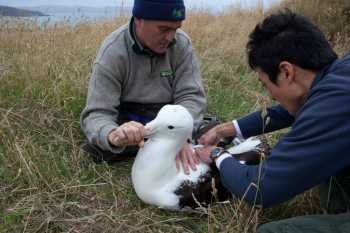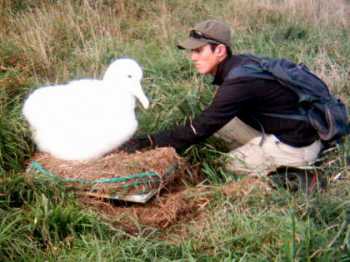Junichi (Jun) Sugishita is a PhD candidate in the Department of Zoology at the University of Otago in Dunedin, New Zealand. He is currently employed at the Royal Albatross Centre at Taiaroa Head near Dunedin as a guide.
Since May 2011 he has been studying the Northern Royal Albatrosses Diomedea sanfordi that breed on Taiaroa Head, following work experiences with Laysan Phoebastria immutabilis and Black-footed P. nigripes Albatrosses on Midway Atoll in the Northwestern Hawaiian Islands a few years back (click here).
Jun's PhD research, supervised by University of Otago Associate Professor Phillip Seddon, aims to understand patterns in the ocean where parent albatrosses go to find food and how much food they bring back to their chicks. Another goal is to gain an understanding of when and how albatrosses interact with commercial fishing vessels. He has been deploying solar-powered GPS (Global Positioning System) units back-mounted on breeding birds, along with leg-mounted temperature loggers. The two devices in conjunction will tell him where at sea the birds are landing on the surface to feed.

Jun Sugushita fixes a GPS tag to a Northern Royal Albatross, held by Lyndon Perriman, DOC Ranger, at Taiaroa Head
Photograph by Keith Payne
The GPS units have been developed by staff and students in the University of Otago's Department of Physics (click here). Learn more about the tags at http://www.odt.co.nz/news/dunedin/179111/gps-tags-developed-track-albatross.
"So far, data sent back had shown the albatross were travelling both south and north for distances up to 70 km a day - past the continental shelf to the open ocean. It was hoped the tags would stay on the birds for more than nine months, Mr Sugishita said. ‘We want to see if adolescent birds have different feeding areas to the others.' The data gathered from both would then be cross-referenced with data from fishing vessel locations to see if their foraging areas were the same as fishing areas". (click here)

Jun Sugishita adjusts an automatic weighing nest under an albatross chick at Taiaroa Head
Photograph taken by time-lapse camera
Click here to watch a short video on Jun's project.
The PhD project is supported by the Otago Peninsula Trust, Department of Conservation Otago Conservancy, Forest & Bird Dunedin Branch, Port Otago Ltd., the Department of Zoology, University of Otago and Ministry for Science and Innovation Grant UOOX0904.
With thanks to Jun Sugishita for information
John Cooper, ACAP Information Officer, 26 May 2012

 English
English  Français
Français  Español
Español